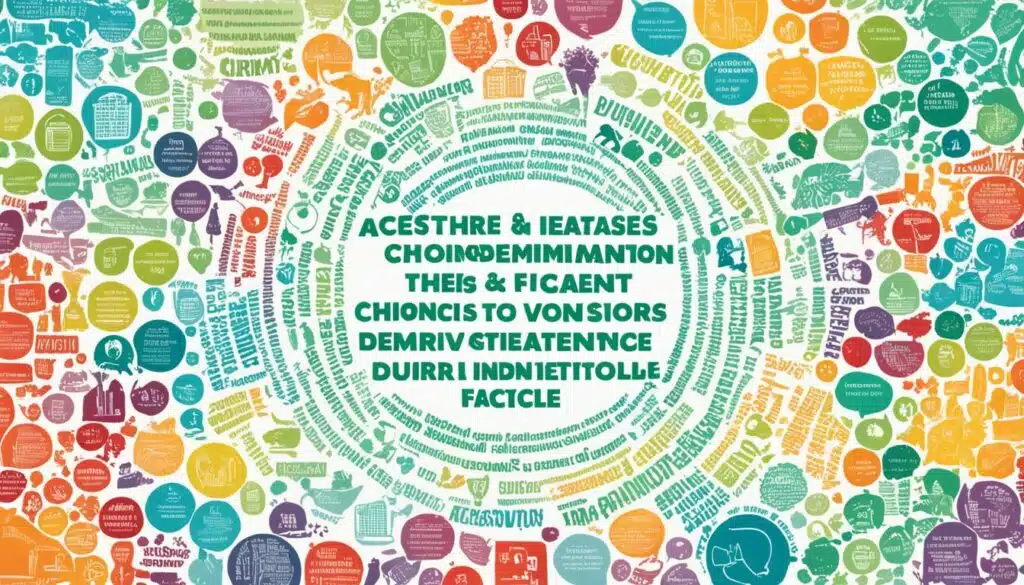Chronic diseases are a big concern in the United States. They include heart disease, cancer, diabetes, and chronic obstructive pulmonary disease (COPD). These conditions are the top causes of death and disability. They cost the healthcare system a lot, about $4.5 trillion every year. Yet, many of these diseases can be avoided. They often develop due to things we can change, like smoking, poor nutrition, physical inactivity, and excessive alcohol use.
It’s key to understand why chronic diseases are so common. It helps us make better plans to fight them. Learning about the causes and who is most at risk is crucial. This info can help us know how to stop, treat, and lower the impact of chronic diseases in the U.S.
Key Takeaways
- Chronic diseases last a long time and need constant medical care. They can also make daily life harder.
- Heart disease, cancer, diabetes, COPD, arthritis, and Alzheimer’s are main types of chronic diseases.
- Bad habits like smoking, unhealthy eating, not exercising, and too much drinking can lead to these diseases.
- Chronic diseases are the top reasons for death and disability in the U.S. They cost a lot to treat and lower quality of life.
- Working on things that influence health is important to make sure everyone has a fair chance to be healthy.
Understanding Chronic Diseases
Chronic diseases last for a year or more and need regular medical care. They include heart disease, cancer, and diabetes. These are the top causes of death and disability in America.
Definition and Characteristics
Chronic illnesses last a long time and need constant medical help. They can make daily activities harder. Chronic illnesses like heart disease develop slowly and need ongoing care to prevent complications.
Leading Causes of Chronic Diseases
The main chronic diseases are heart diseases and cancer. There are also respiratory and neurological conditions. These diseases are the top causes of death and are a big burden on health systems and society.
Risk Factors for Chronic Diseases
Smoking, poor nutrition, and lack of exercise are key risk factors. Excessive drinking also plays a big part. Preventing these behaviors can help avoid many health issues.
Prevalence of Chronic Diseases

Chronic diseases top the list of reasons for death and disability in the U.S. They cause 4 out of 5 deaths. Many Americans battle heart disease, cancer, diabetes, and COPD. This makes the prevalence of chronic diseases a big worry in public health.
Statistics on Chronic Disease Burden
The chronic disease statistics from the CDC tell us that these diseases lead to 7 out of 10 deaths yearly in the U.S. They are also the main reason for the high healthcare costs. Treating chronic diseases costs over $4.5 trillion each year.
Vulnerable Populations and Health Disparities
Some groups are hit harder by chronic diseases. These include racial and ethnic minorities, those with lower incomes, and older adults. They often experience health disparities from limited healthcare access, education, and health resources.
African Americans and Hispanic/Latino Americans often deal with higher rates of diabetes, heart disease, and stroke than white Americans. Also, people from low-income families face more struggles with chronic diseases. This is because they may not access preventive care or have enough resources to manage their health.
| Chronic Disease | Prevalence by Race/Ethnicity | Prevalence by Income Level |
|---|---|---|
| Diabetes |
|
|
| Heart Disease |
|
|
| Chronic Obstructive Pulmonary Disease (COPD) |
|
|
It’s very important to address these health disparities. Public health organizations and healthcare providers must work to ensure everyone can access resources for preventing and managing chronic diseases.
Impact of Chronic Diseases

Chronic diseases like heart disease, cancer, and diabetes harm our health. They also cost a lot to the healthcare system. The societal impact of these chronic disease costs is a big issue for the U.S.
Economic Burden on Healthcare Systems
These diseases are a top reason for the $4.5 trillion in annual healthcare costs. They create a huge economic burden on the healthcare system.
The cost of caring for long-term conditions is heavy. It affects public and private healthcare payers. This situation shows why we must find the root causes and manage chronic diseases better.
Effects on Quality of Life
Chronic illnesses also lower an individual’s quality of life. They might cause disability, reduce work ability, and make daily life hard.
These impacts is more than just costs. They can lead to chronic disease mortality and disability. This is why we need to act to tackle the public health challenge intertwined with chronic diseases.
Chronic Diseases

Chronic diseases are long-term health issues like heart disease, cancer, and diabetes. They also include chronic obstructive pulmonary disease (COPD), arthritis, and Alzheimer’s disease. These are the main health problems for many in the U.S. They last a long time, require constant medical attention, and can limit what you do every day.
There are many types of chronic diseases out there. These cover problems with the heart, lungs, brain, joints, kidneys, and liver. This variety shows how complex managing chronic diseases can be for both patients and doctors.
Living with a chronic condition can be very tough. People often deal with painful symptoms and complications. This can make their daily life hard and affect how well they can manage their health. It’s important to focus on preventing and managing chronic diseases. This helps people live better lives and takes some pressure off the healthcare system.
Preventing Chronic Diseases

Fighting chronic diseases needs a broad approach. It’s crucial to stop these illnesses from starting. This section looks at ways to do this. It includes changing your lifestyle, finding problems early, and working together on health.
Lifestyle Modifications
Many health issues can be avoided by changing how we act. Things like smoking, not eating well, not moving enough, or drinking too much lead to sickness. Making life healthier helps cut the chance of getting ill with things like heart problems, diabetes, or lung disease. We aim to help people make lasting changes by teaching them, providing local programs, and changing rules to support healthy choices.
Early Detection and Screening
Finding health issues early helps a lot. This means getting checked often by a doctor. It helps find things like high blood pressure, high cholesterol, early diabetes, and cancer before they become big problems. More check-ups and making sure everyone knows how important they are can make us all healthier. This also helps avoid big illnesses later.
Public Health Initiatives
Community health plans are key in stopping chronic diseases. They look at the bigger, social reasons behind health. Programs like REACH and Getting Further Faster work on making health fair for everyone. They help cut health differences, make care better, and get everyone involved in staying well.
| Chronic Disease Prevention Strategies | Key Objectives |
|---|---|
| Lifestyle Modifications |
|
| Early Detection and Screening |
|
| Public Health Initiatives |
|
Managing Chronic Conditions

Managing chronic diseases well means taking charge of your health. It’s about using self-care plans, sticking to your medicines, and getting help from support groups.
Self-Management Strategies
Staying healthy when you have a chronic illness means you need to manage things on your own. You should try to be active, eat well, and manage stress. Doing this can help you feel better, stop problems before they start, and enjoy life more.
Medication Adherence
Following your doctor’s medication advice is very important. It stops your disease from getting worse, lowers the risk of issues, and helps you get healthier. Your healthcare team should talk to you about why taking your meds as told is essential and help you with any concerns.
Coordinated Care and Support Systems
Managing chronic illness often means you need help from different healthcare professionals. Working together, they can make it easier for you to find and use important healthcare services. This team effort can make sure you get the care tailored to your needs. It also helps you stay connected with your doctors and supports good health for the long run.
Social Determinants of Health

Where people are born, live, work, and grow old plays a big role in their health. This includes things like their environment, access to healthcare, and what they know about health. These factors can make the rates of chronic diseases higher in some groups.
Environmental Factors
The places people spend time can make them more likely to get chronic diseases. For example, breathing in dirty air or living in bad housing can be risky. It can lead to health issues like heart problems or lung diseases. Helping to fix these problems in neighborhoods can make a big difference in people’s health.
Access to Healthcare
Some people might not get the healthcare they need because of many reasons. This could be a lack of insurance or not enough doctors close by. To help everyone fight chronic diseases, we need to make sure healthcare is fair and available to all.
Education and Awareness
Not knowing enough about chronic diseases can be a problem. This means not understanding how to stay healthy or care for yourself. Teaching people more about chronic diseases can help them take better care of themselves. It can also help prevent more health issues.
Role of Public Health Agencies

Chronic diseases are a big challenge for public health. So, the work of government agencies and health groups is super important. The CDC’s National Center for Chronic Disease Prevention and Health Promotion is a key player here. It helps states, cities, tribes, and territories fight chronic diseases and improve health.
CDC’s National Center for Chronic Disease Prevention
The CDC’s National Center for Chronic Disease Prevention and Health Promotion leads efforts to fight chronic diseases. It offers a lot of help like money and advice to state and local public health agencies. This support makes it easier to stop and manage chronic diseases.
State and Local Programs
Working with the CDC, state and local programs are tackling chronic diseases. They focus on things like putting proven chronic disease policies in place, improving chronic disease data collection, and building chronic disease partnerships. These efforts help promote health and run programs in the community.
Emerging Trends and Research

The field of fighting and managing chronic diseases is always changing. New trends and research are influencing how we deal with these issues. Discoveries in precision medicine and personalized care are leading to better patient results and lower healthcare expenses.
Precision Medicine and Personalized Care
Now, doctors can customize care to fit each person’s genetics, lifestyle, and surroundings. Thanks to advances in chronic disease research and data, healthcare experts make treatments that are right for each patient. This personal technique can make patients more committed and make handling chronic diseases better.
Technological Advancements
Advances in technological innovations are also changing how we manage chronic diseases. The use of telehealth and devices for remote monitoring, along with data analytics and artificial intelligence, is making care more accessible and tailored. Digital health tools including mobile health apps and digital therapeutics are encouraging patients to play a bigger part in taking care of their chronic conditions. This is improving results and cutting down on healthcare spending.
Also Read : Surgery In The Age Of Precision Medicine: Tailored Treatments
Collaborative Efforts
Tackling chronic diseases is tough but vital and needs teamwork. It involves many, like doctors, officials, and advocates. Together, they develop strategies that fit each community’s needs, starting from the ground up.
Community Engagement
To truly help, diving into local communities is key. This way, groups from different backgrounds can join forces. They weave services and resources into the community, making them truly count.
Partnerships and Coalitions
Building partnerships across various fields is crucial. It lets experts come together and act against chronic diseases in a way that’s thorough and fair. The result is better care for those in need, backed by solid teamwork.
FAQs
Q: What are some common chronic diseases and conditions?
A: Some common chronic diseases and conditions include heart disease, diabetes, chronic obstructive pulmonary disease (COPD), obesity, arthritis, and high blood pressure.
Q: Why are chronic diseases so prevalent?
A: Chronic diseases are prevalent due to factors such as aging populations, unhealthy lifestyle choices, genetic predisposition, environmental factors, and lack of access to healthcare services.
Q: How can chronic diseases be managed?
A: Chronic diseases can be managed through a combination of medication, lifestyle changes, regular medical check-ups, therapy, and in some cases, surgical interventions.
Q: What is the role of the CDC in tackling chronic diseases?
A: The Centers for Disease Control and Prevention (CDC) plays a vital role in disease control and prevention, implementing programs and initiatives to reduce the burden of chronic diseases in America.
Q: Are chronic diseases more common in older adults?
A: Yes, chronic diseases are more common in older adults due to age-related health conditions and a higher likelihood of developing multiple chronic conditions.
Q: What are the leading causes of chronic diseases in America?
A: Some of the leading causes of chronic diseases in America include obesity, cardiovascular disease, type 2 diabetes, chronic respiratory diseases, and arthritis.
Q: How can we reduce the prevalence of chronic diseases in health care systems?
A: The reduction of chronic diseases in healthcare systems can be achieved through education, early detection, preventive measures, promoting healthy lifestyles, and investing in chronic disease management programs.
Q: What is the National Center for Health Statistics’ role in chronic disease management?
A: The National Center for Health Statistics gathers and analyzes data related to chronic diseases, providing valuable insights for public health strategies and policies aimed at improving chronic disease outcomes.





